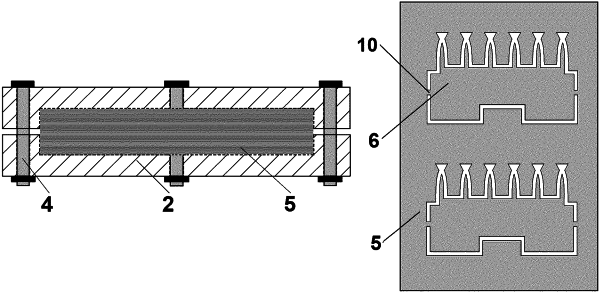| CPC A61M 37/0015 (2013.01) [B23P 17/04 (2013.01); A61M 2037/0053 (2013.01); Y10T 29/49995 (2015.01)] | 2 Claims |

|
1. A manufacturing method for an in-plane metal microneedle array, the method comprising the following steps:
step 1: using medical stainless steel or titanium alloy metal sheet material as a microneedle material, wherein a thickness of the metal sheet is 20-200 microns;
step 2: cutting the metal sheet into smaller metal sheets, wherein each smaller metal sheet has a length of 30-50 mm and a width of 10-30 mm;
step 3: processing a special sheet clamping tooling;
the tooling is composed of two identical upper and lower metal cover plates, and an overall thickness of each cover plate is 5-10 mm; inner walls of the upper and the lower cover plates of the tooling are processed with grooves, each groove has a length and a width matching the length and the width of the smaller metal sheet for receiving the smaller metal sheet therein;
a depth of each groove of the upper and lower cover plates are 1-5 mm; through holes for passing through fastening bolts are processed at edges around the upper and lower cover plates;
step 4: placing a number of the smaller metal sheets in one of the grooves of one of the upper and lower cover metal cover plates; adjusting the number of the smaller metal sheets placed at one time according to a combined thickness of the smaller metal sheets and the depth of the one of the grooves; placing the other one of the upper and lower metal cover plates on the one metal cover plate on which the smaller metal sheets are placed, with the one of the grooves facing the smaller metal sheets and aligned up and down; then encapsulating and fastening the upper and the lower metal cover plates by the fastening bolts, and compacting the smaller metal sheets to form a whole with the upper and the lower metal cover plates, wherein the number of the smaller metal sheets placed at one time is in a range of 20-200;
step 5: designing geometries and sizes of sheet in-plane metal microneedles;
a sheet in-plane metal microneedle array is composed of substrates and microneedle bodies for a subsequent clamping part; the microneedle bodies are arranged above the substrates; positioning shoulders are arranged on both sides above the substrates for positioning guidance of an inserting auxiliary device; a positioning guide groove is arranged in a lower middle of each substrate for subsequent assembly of each substrate;
step 6: clamping the smaller metal sheets and the tooling encapsulated in step 4 to a wire cutting device, determining a wire path according to the geometries and sizes of the sheet plane metal microneedles designed in step 5 by the wire cutting device, conducting wire cutting on the tooling and the smaller metal sheets as a whole, and processing the smaller metal sheets into the substrates and the microneedle bodies; in the wire cutting process, the tips of the microneedle bodies are cut in a figure 8-shape to ensure sharpness of microneedle tips; during processing, both sides of the substrates are reserved for 2 to 5 mm without cutting to ensure that the clamping tooling and the smaller metal sheets still form a whole after processing;
step 7: taking off the fastening bolts on the tooling, and taking out and washing the processed smaller metal sheets to obtain microneedle substrates which are not cut;
step 8: cutting the microneedle substrates obtained in step 7, and removing the material on regions reserved on both sides of the substrates to separate the sheet in-plane metal microneedles from the smaller metal sheets to obtain a sheet in-plane metal microneedle array with a plurality of microneedle bodies;
wherein a height of each microneedle body is 1-5 mm, a width of a root of each microneedle body is 50-500 microns, and a thickness of each microneedle body is the thickness of the metal sheet; the number of the microneedles on each substrate is 3-50, and a distance between each pair of microneedles is 0.25-10 mm; positioning shoulders are arranged on both sides above the substrates for positioning guidance of an inserting auxiliary device; a positioning guide groove is arranged in the lower middle of each substrate for subsequent assembly of each substrate;
the microneedle bodies adopt equal-strength design along a length direction, that is, the width change of the microneedle bodies needs to ensure that the microneedle bodies have same maximum bending stress at each cross section when tips are subjected to a transverse concentrated load; if the root of each microneedle body is a starting point of x axis, the x axis is located on a longitudinal symmetry axis of each microneedle body, and a width direction is assumed to be a y axis, then the equal-strength design requires that x and y satisfy the following relationship in the following formula:
γ=±C√L0−x;
wherein L0 is the length of the microneedle bodies, and C is a constant which comprehensively reflects the yield strength of the material, the thickness of the microneedles, and a load size.
|